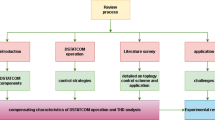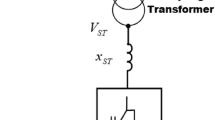Abstract
The conventional unified power quality conditioner (UPQC) includes a series active power filter (SAPF) and a parallel active power filter (PAPF). The former is used for voltage compensation, whereas the latter is used for harmonic and reactive power compensation. Because the SAPF always maintains an idle state, the UPQC function is relatively independent, and its utilization rate is low. To improve the UPQC performance more efficiently, a coordinated control strategy for UPQCs is established using a dynamic collaborative task-solving scheme based on a multi-agent scheme is proposed. First, the dynamic collaborative task-solving scheme based on a multi-agent system is illustrated. Next, the theoretical analysis of reactive power flow in a UPQC is discussed. Considering that no power quality problems such as voltage sag exist on the series side of the UPQC, the SAPF is used for reactive power compensation, and the PAFP is used for harmonic compensation based on the coordinated control strategy. To verify the validity and feasibility of the proposed control strategy, a simulation model is constructed in Simulink. The simulation results demonstrate the feasibility and validity of the proposed coordinated control strategy. The experimental results prove that the SAPF and PAPF can compensate for the reactive power and harmonics, respectively. The proposed strategy can be employed to improve the power quality of the microgrid effectively. Furthermore, it improves the comprehensive compensation performance of UPQCs and provides a new method for engineering applications.















Similar content being viewed by others
References
Santanu Kumar, D., Pravat, K.R.: Power quality improvement utilizing PV fed unified power quality conditioner based on UV-PI and PR-R controller. Power Electron Appl 3(3), 243–253 (2018)
Yong, Y., Guiping, Z., Xiucheng, L.: Improvement of power quality of micro-grids by battery energy storage system. Trans. Chin. Electrotech. Soc. 27(1), 85–89 (2012)
Leonardo BGC, S´ergio Augusto Oliveira da S., Albano de Oliveira Jr, A., Bacon, V. D.: Single-stage three-phase grid-tied PV system with universal filtering capability applied to DG Systems and AC microgrids. Power Electron. 32(12), 9131–9142 (2017)
Lakshmi, S., Ganguly, S.: Simultaneous optimisation of photovoltaic hosting capacity and energy loss of radial distribution networks with open unified power quality conditioner allocation. IET Renew Power Gen. 12(12), 1382–1389 (2018)
Shengqing, L., Weizhou, L., Wenxiang, X., Huanyue, Z., Kexi, H.: Combination research of micro-grid storage unit and active power filter. Power Syst. Protect. Control 41(18), 57–63 (2013)
Basu, M., Das, S.P., Dubey, G.K.: Investigation on the performance of UPQC-Q for voltage sag mitigation and power quality improvement at a critical load point. IET Gen. Transm. Distrib. 2(3), 414–423 (2008)
Khadkikar, V.: Enhancing electric power quality using UPQC: a comprehensive overview. IEEE Trans. Power Electron. 27(5), 2284–2297 (2012)
Quocnam, T., Lee, H.H.: Improvement of unified power quality conditioner performance with enhanced resonant control strategy. IET Gen. Transmiss. Distrib. 8(12), 2114–2123 (2014)
Wei Jiang, Wu., Chen, R.H., et al.: United power quality conditioner based on supercapacitor for microgird. Electr. Power Autom. Equip. 34(1), 85–90 (2014)
Sanjib, G.: Impact of unified power-quality conditioner allocation on line loading, losses, and voltage stability of radial distribution systems. Power Deliv. 29(4), 1859–1867 (2014)
Luis Fernando Correa, M., Mauricio, A., Jose Gabriel, P., Bruno Fernandes, E., Joao, L.A.: Control algorithms based on the active and non-active currents for a UPQC without series transformers. IET Power Electron. 9(9), 1985–1994 (2016)
Fuyin, N., Zhengming, L., Qi, W., Songlin, W.: UPQC voltage sag detection based on chaotic immune genetic algorithm. Cluster Comput. J. Netw. softw. Tool. Appl. 19(4), 1–13(2016)
Yong, L., Guochun, X., Xiongfei, W., Frede, B., Dapeng, L.: Control strategy for single-phase transformerless three-leg unified power quality conditioner based on space vector modulation. Power Electron. 31(4), 2840–2849 (2016)
Qiming, C., Gen, C., Yinman, C., Ming, L., Helin, W.: Research of modified double hysteresis current control method at parallel side of UPQC. Electr. Mach. Control 18(4), 102–110 (2014)
Rodrigo Augusto, M., S´ergio Augusto Oliveira da, S.: A versatile unified power quality conditioner applied to three-phase four-wire distribution systems using a dual control strategy. Power Electron. 31(8), 5503–5514 (2016)
Eklas, H., Mehmet, R., Sanjeevikumar, P., Selim, A., Imtiaj, K.: Analysis and mitigation of power quality issues in distributed generation systems using custom power devices. IEEE Access, (6), 16816–16833(2018)
Karthikrajan, S., Iyswarya, A.: Implementation of unified power quality conditioner (UPQC) based on current source converters for distribution grid and performance monitoring through LabVIEW Simulation Interface Toolkit server: a cyber physical model. IET Gen. Transm. Distrib. 10(11), 2622–2630 (2016)
Abdul, Q. A., Bhim, S., Mashhood, H.: Algorithm for power angle control to improve power quality in distribution system using unified power quality conditioner. ET Gen. Transm. Distrib. 9(12), 1439–1447 (2015)
Sachin, D., Bhim, S.: Control of solar photovoltaic integrated UPQC operating in polluted utility conditions. IET Power Electron. 10(12), 1413–1421 (2017)
Bruno, W. F., Leonardo F. da S., Maynara A. A., Maurício A.: An improved UPQC controller to provide additional grid-voltage regulation as a STATCOM. Ind Electron. 62(3), 1345–1352 (2015)
Vinod. K., Ambrish, C.: UPQC-S: A novel concept of simultaneous voltage sag/swell and load reactive power compensations utilizing series inverter of UPQC. Power Electron. 26(9), 2414–2425 (2011)
Xingtian, F., Tongzhen, W., Zhiping, Q.: Coordinated control strategy of power flow in voltage quality conditioner. Power Syst. 37(1), 218–223 (2013)
Bo, H., Kaigui, X., Yuan, Z., Kan, C.: Parallel Algorithm for reliability evaluation of bulk power system with dynamic task allocation technique. Automation of electric power system, 35(10), 35–41(2011)
Jiang, W., Luo, F., Shi, D.: Modeling and solving dynamic collarborative tasks in a multi- gent system. CAAI Trans. Intell Syst. 5(2), 161–168(2010)
Liang, Z., Shu, H., Liu, Z., Yu, J.: Completely decoupled direct control strategy of UPQC. Electr. Power Autom. Equip. 29(4), 27–31, 130 (2009)
Jia, L. Liu, G., Qin, Y.: The Dynamic Collaborative Task Soling Base on Agent. The Science Press, New York (2007)
Xingtian, F., Wenzhong, M., Qunhai, H.: Coordinated control strategy based on reactive power flow in UPQC. Electr. Mach. Control 17(4), 1–5 (2013)
Acknowledgments
This work was supported in part by the National Natural Science Foundation of China (51477070); in part by National Key R&D Program of China (017YFB0103200);
Author information
Authors and Affiliations
Corresponding author
Additional information
Publisher's Note
Springer Nature remains neutral with regard to jurisdictional claims in published maps and institutional affiliations.
Rights and permissions
About this article
Cite this article
Ni, F., Wo, S. & Li, Z. Coordinated control strategy of UPQC by dynamic collaborative task-solving scheme based on multi-agent system. Energy Syst 13, 215–233 (2022). https://doi.org/10.1007/s12667-020-00415-7
Received:
Accepted:
Published:
Issue Date:
DOI: https://doi.org/10.1007/s12667-020-00415-7




